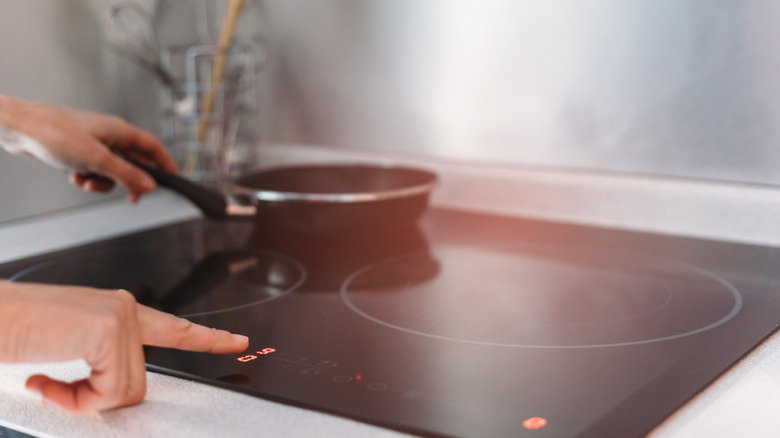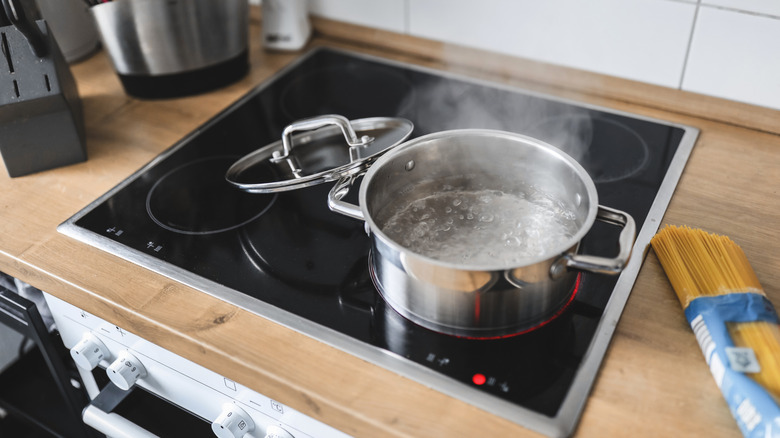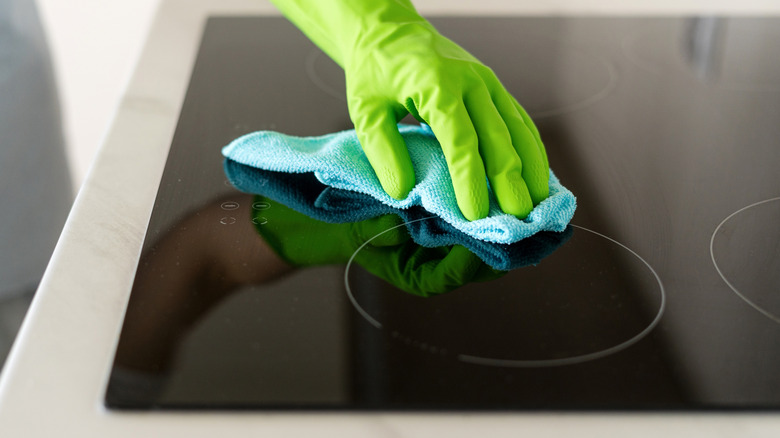Why Your Induction Stove Has Water Stains (And How To Fix It)
For home cooks who love the control and accuracy that gas stovetops provide but wish they were as easy to clean as glass-top electric stovetops, induction stoves are the perfect combination of the two. In fact, among the pros and cons of induction range ovens, their easy cleanup is one of the advantages that convinces homeowners to make the switch. However, while an induction cooktop is smooth and stays cool enough to avoid burning food and spills onto the surface, there is one unlikely stain that can pose an issue: Water stains. Water stains typically occur on induction stoves because hard water contains minerals that leave deposits behind as it dries. Fortunately, you don't need to buy a specialty cleaner to remove the stains. The white vinegar you may already have in your pantry can work wonders for removing water stains from an induction cooktop.
Instead of the flames or burners that traditional stovetops use, an induction range relies on electromagnetic energy to cook food. Electric currents pass through copper wires that sit beneath its ceramic-glass cooktop and create a magnetic field. When you place compatible cookware, such as stainless steel or cast-iron pots and pans, on the stove, this field passes electric currents through to the pan to heat it. As a result, an induction stovetop heats up very quickly and then cools just as fast when you remove the cookware.
Why water stains occur on induction stovetops
Most water stains that occur on home appliances, such as induction stovetops or dishwashers, are due to hard water. Hard water is water that contains high levels of dissolved minerals, most notably calcium and magnesium. When the water evaporates, a chalky residue or stain is left behind.
On an induction cooktop, water stains can be left during cooking, such as when a pot of water for pasta boils over, or during the cleaning process. However, while an induction cooktop doesn't get hot enough to cook food stains onto the surface, it heats up enough for hard water to evaporate. That's because the evaporation of water can occur over a wide temperature range, including in room-temperature water.
Not sure how to tell how hard your water is? You can purchase an at-home water testing kit, but some signs you have hard water include feeling a residue on your hands or in your hair after washing, spots on your dishes after cleaning, clothes that feel stiff after laundry, and frequent clogs in your pipes.
How to clean water stains on an induction stovetop
Although it is usually easy to clean an induction stove top, removing water stains can be tricky. Wiping down with your usual simple cleaning solution may not be enough to get the job done, but it doesn't necessarily require purchasing a specialty cleaning or decaling product. While you've probably heard plenty of induction stovetop cleaning tips, it might be difficult to find anything as effective at removing hard water stains as white vinegar. The acetic acid in vinegar helps break down calcium, magnesium, and other mineral deposits left behind by hard water quickly, without leaving any streaks or spots. Any type of distilled white vinegar can work, but you'll get the best results from vinegar formulated for cleaning with at least 6% acidity.
To remove water stains from your induction stovetop, dampen a clean, soft cloth with white vinegar. Dab the spots with the towel, and allow the vinegar to sit on the area for some minutes. Next, wipe the stains with the cloth to remove them. Dampen another clean towel with distilled water, and use it to rinse the stovetop. Finally, dry the surface with a clean microfiber cloth.


